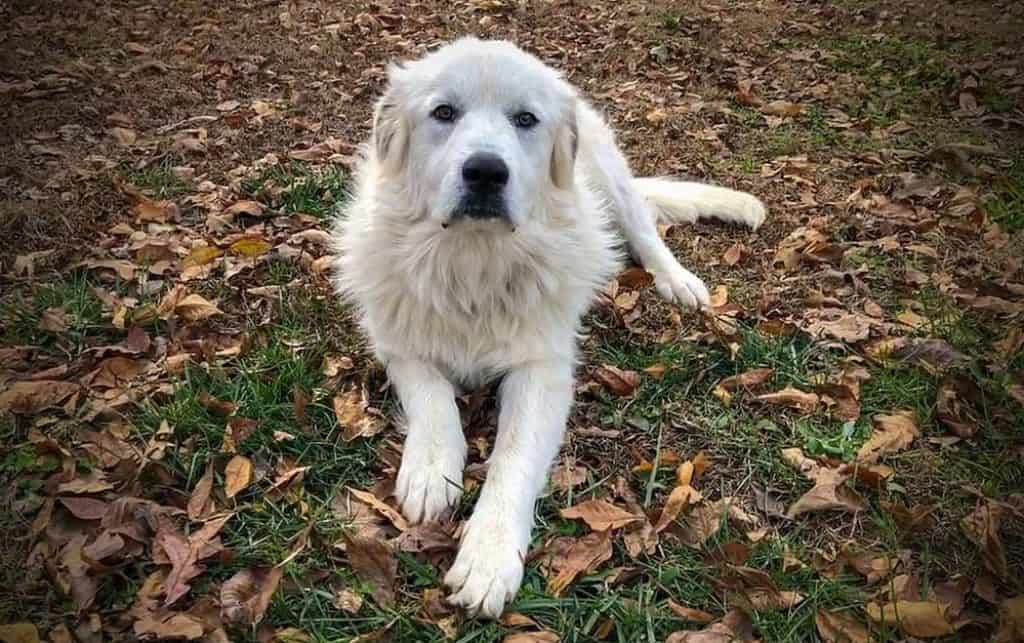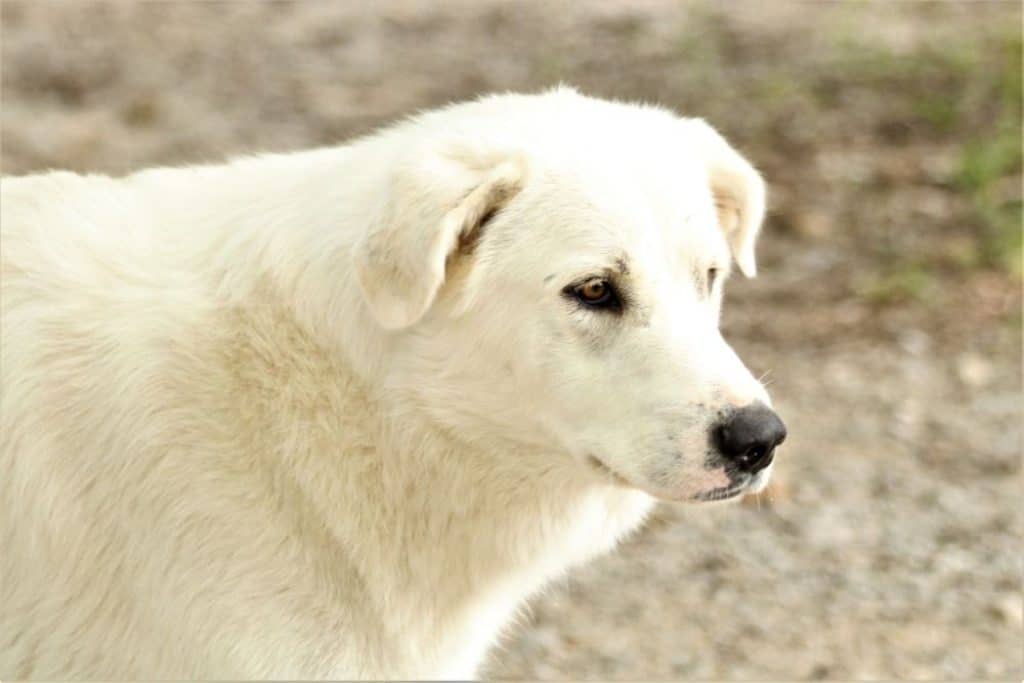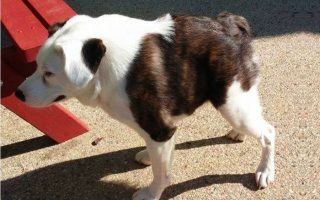When thinking about which dog to get and researching their traits and characteristics, most potential owners look into coat length and color, height and weight, or just general appearance.
People interested in getting a Great Pyrenees were usually impressed with their size, lush white fur, and imposing status.
They rarely stop to think about what type of paws they have.
Still, feet are a vital part of a dog’s body.
Depending on what are your plans with the dog, the paw type may play a big role.
If you’ve set your sights on getting a Pyr, one of the questions you should have an answer to is do Great Pyrenees have webbed feet.
Below, I’ll explain why this is important and provide other useful information about dogs’ webbed feet.
So; let’s dive in!
[wpsm_toplist]
Do Great Pyrenees Have Webbed Feet?

While most people think that webbed feet are specific only to certain breeds, the truth is that most dogs have webbing between their feet.
In fact, all land mammals have webbed feet in the embryo stage, but for most, it goes away as they develop. Great Pyrenees are no exception here.
So, if you were wondering if the Great Pyrenees have webbed feet, the answer is yes.
However, the webbing is not as pronounced as it is with some other breeds. It’s also not a defining trait for Pyrs.
Breeds that have fully webbed feet were bred for water activity, mainly to assist fishermen or hunters.
Great Pyrenees, on the other hand, are a mountain breed, developed to protect the livestock in the mountain areas.
Still, their limited feet webbing helps them get extra stability on rough mountain terrain and move more easily across the snow.
How To Take Care Of The Webbed Feet Of Your Great Pyrenees

Although webbed feet are not the Great Pyrenees’ most prominent characteristic, you should still learn how to care for them.
A lot of owners don’t pay a lot of attention to feet when cleaning and grooming their dogs.
Make sure you don’t make the same mistake as it can make your dog uncomfortable and even lead to some serious health issues.
Below, you’ll find a few tips on how to care for Pyr’s webbed paws.
Clean the Webbing After the Dog’s been Outside
Make sure to make webbing cleaning a part of your regular routine as the dogs come back inside the house.
You should do this no matter what was the weather outside or if your dog walked on the dry, muddy, wet, or snowy surface.
You should remove any traces of dirt, grime, mud, or snow.
If anything of this is left on the webbing, it may cause an infection or other foot diseases.
Great Pyrenees have abundant fur and a lot of dirt gets caught every time they go out.
Always Dry the Dog’s Webbed Feet
It goes without saying that your dog’s feet should be dry whenever it’s possible.
Pyrs don’t really care if it’s snowy or wet outside, so they’ll often come inside with wet feet.
Drying the webbing will help you maintain their foot hygiene and decrease the risk of illness.
Make Sure to Inspect the Webbing
It’s always a good idea to inspect the webbing on Pyr’s feet from time to time.
You can do this every time you brush your dog. This will help you detect any potential injury or infection.
Look for any change from the normal look of the webbed feet. Even a slight discoloration may be a reason to worry and contact the vet.
Also, make sure that there’s nothing stuck in the webbing, like a thorn or wood splinter.
Discovering any potential issue on time will often prevent more serious health problems.
Consider Snow Boots
[amazon box=”B089RJBPHR”]
Even though Great Pyrenees handle the winter conditions fairly well, you still may consider buying snow boots for your dog.
They will protect their paws and the webbing from the harsh snow and keep their feet drier.
Benefits of Webbed Feet in Dogs

Webbed feet in dogs are not some freak genetic mutation, but they often play a crucial role.
They help dogs perform the tasks they were bred for. Below, I’ll list the most common benefits that webbed paws bring.
Helpful for Swimming
You’re probably aware that all animals that spend time in the water, such as ducks and frogs, have webbing on their feet.
The situation is not much different in the canine world.
Most water breeds, that excel as swimmers, such as Labrador Retrievers, Newfoundland’s, or Otterhounds, feature paws with prominent webbing.
The membranes between the toes that these dogs have practically serve as paddles and propel them forward with every leg stroke.
They help them swim faster, spend less energy, and allow them to better control their movement through the water.
On the other hand, breeds with less pronounced webbing and less surface area between the toes, such as Great Pyrenees, will have trouble navigating their way in the water.
You still can get these pooches in the water, but they may struggle more and waste a lot more energy than natural water breeds.
Easier Movement Across Different Terrains
Another benefit the dogs have from their webbed feet is that they help them move across various terrains.
This is particularly important for mountain breeds as they’re often faced with rough terrain.
Webbing on the paws gives them more stability, even on a rocky surface with lots of bumps and creases.
The membranes act as a net that increases the amount of grip between the dog’s paw and ground.
This way, webbing prevents dogs from getting stuck or slipping on muddy or mushy surfaces.
All this allows canines to move faster and more efficiently.
Better in Snow
Some breeds just love the snow and are capable of spending countless hours outside once the winter comes.
However, not all of them are equally equipped for movement through the snow.
Those with more prominent webbing on their feet will be faster and more agile.
Membranes between the toes increase the surface of the foot helping the dogs maintain stability on the snow and avoid sinking.
Not much different from the snowshoes worn by lumberjacks, hunters, or polar explorers.
Better at Digging
If you’ve ever owned a dog, you know how much they love to dig.
This is not something that can be counted as a desired behavior but, nevertheless, it’s something dogs do and enjoy.
Still, for some hunting breeds, it is a useful trait as they often have to dig the prey up. And webbed feet are very helpful in their digging endeavors.
Similar to swimming where they use their feet as paddles, here the webbing creates a sort of a scoop that helps them move the dirt around and dig holes.
Different Types of Dog Paws
Different dog breeds feature different types of paws, mostly suited for the certain canine’s main purpose.
There are three main categories of dog paws.
Cat’s Feet
The name “cat’s feet” doesn’t refer to retractable claws, but simply to the neat and round shape of dog paws.
Dogs with this type of paws commonly have high-arched toes that are held together rather closely.
They also feature a short third digital bone which helps dogs lift of the ground using less energy,
This allows them to walk, run, or jump continuously without really tiring. This type of paw is common for dog breeds where high endurance is required.
These are mostly working dogs such as Dobermans, Akitas, or Giant Schnauzers.
Hare Feet
Just like cat’s feet are catlike, this type of paws is similar to the rabbit’s feet.
The most distinctive feature in the category of dog paws is the two middle toes which are longer than the ones on the sides.
In addition, the toes are less arched, making the whole foot seem longer.
Dogs with this type of feet have a longer third digital bone which means that they need more energy to move compared to those with cat’s feet.
On the other hand, hare feet provide dogs with more speed and better acceleration. The best-known dogs in this category are Greyhounds.
Webbed Feet
Dogs with webbed feet are those with a skin membrane between their toes. It’s somewhat similar to the feet that aquatic animals have.
Most dogs have webbed feet to some degree, but only those specifically bred to work in water have a fully grown webbing.
They’re mostly used by hunters or fishermen to retrieve downed birds or track down otters.
The most famous representative of dogs with webbed feet is Labrador Retriever.
Conclusion
If your Pyr is mostly a family dog, spending most of its time around the house, you shouldn’t be too concerned with the question do the Great Pyrenees have webbed feet.
However, if you plan to take your pyr swimming or have it run around snowy or mushy surfaces often, then you should learn more about webbed feet.
Pyr is among the group of dogs with medium-sized webbing on their feet which suits them perfectly for what they are bred to do.
The webbing on their paws may not make them the best swimmers but is more than helpful when moving across rough terrain or snow.
Even though their webbing is not that prominent, you should still pay attention to it and check it regularly as a part of your care routine.







